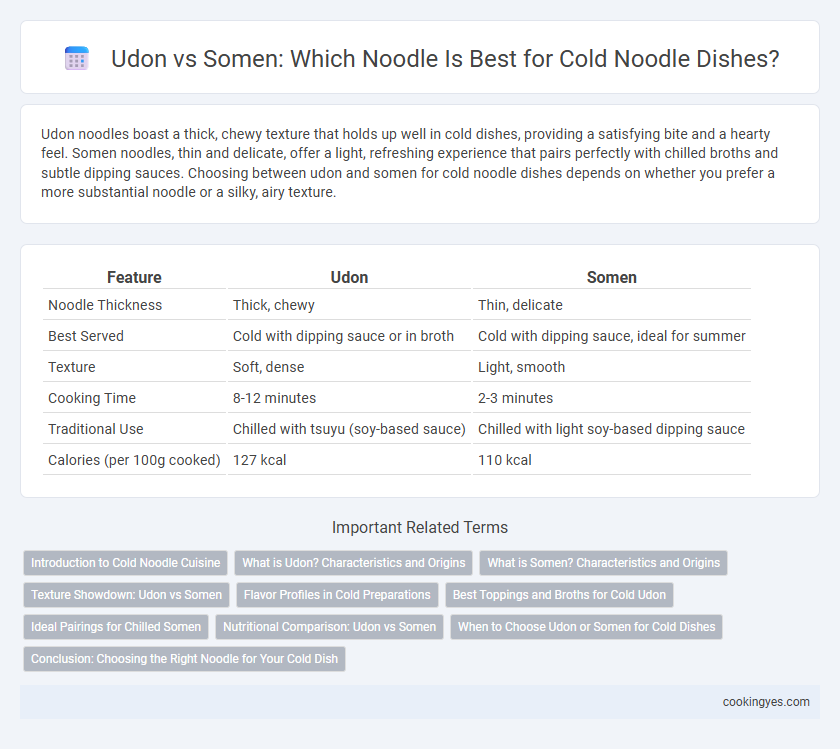Udon noodles boast a thick, chewy texture that holds up well in cold dishes, providing a satisfying bite and a hearty feel. Somen noodles, thin and delicate, offer a light, refreshing experience that pairs perfectly with chilled broths and subtle dipping sauces. Choosing between udon and somen for cold noodle dishes depends on whether you prefer a more substantial noodle or a silky, airy texture.
Table of Comparison
| Feature | Udon | Somen |
|---|---|---|
| Noodle Thickness | Thick, chewy | Thin, delicate |
| Best Served | Cold with dipping sauce or in broth | Cold with dipping sauce, ideal for summer |
| Texture | Soft, dense | Light, smooth |
| Cooking Time | 8-12 minutes | 2-3 minutes |
| Traditional Use | Chilled with tsuyu (soy-based sauce) | Chilled with light soy-based dipping sauce |
| Calories (per 100g cooked) | 127 kcal | 110 kcal |
Introduction to Cold Noodle Cuisine
Cold noodle cuisine highlights refreshing textures and subtle flavors that balance and invigorate the palate. Udon, thick and chewy, offers a satisfying bite ideal for hearty cold broth or dipping sauces, while somen's thin, delicate strands excel in light, chilled presentations that emphasize crispness and ease of consumption. Both noodles celebrate diverse regional styles in Japanese cuisine, enhancing summer dining with their distinctive mouthfeel and temperature contrast.
What is Udon? Characteristics and Origins
Udon is a thick, chewy Japanese wheat noodle distinguished by its smooth, slippery texture and mild flavor, ideal for absorbing sauces and broths. Originating from Japan's Sanuki region, udon has been a staple since the 9th century, often served in hot or cold dishes with various toppings. Its substantial thickness contrasts with the thinner, more delicate somen noodles, making udon a heartier choice for cold noodle preparations.
What is Somen? Characteristics and Origins
Somen is a thin, white Japanese noodle made from wheat flour, known for its delicate texture and subtle flavor, making it ideal for cold noodle dishes. Originating from Japan, somen is traditionally served chilled with a light dipping sauce, particularly enjoyed during the summer months. Its fine thickness and smooth consistency distinguish it from thicker noodles like udon, offering a refreshing and easily digestible meal option.
Texture Showdown: Udon vs Somen
Udon noodles boast a thick, chewy texture that holds up well in cold dishes, delivering a satisfying bite with each forkful. Somen noodles feature a delicate, thin profile that offers a light, smooth mouthfeel, making them ideal for refreshing summer meals. The contrasting textures create distinct eating experiences, with udon providing heartiness and somen delivering subtle grace.
Flavor Profiles in Cold Preparations
Udon noodles offer a chewy texture and mild wheat flavor that pairs well with light soy-based dipping sauces, enhancing the refreshing qualities of cold dishes. Somen noodles, thinner and smoother, have a delicate taste that absorbs broths and dressings quickly, making them ideal for subtly flavored cold presentations. Both noodles complement cold preparations but differ in mouthfeel and flavor intensity, influencing the overall sensory experience.
Best Toppings and Broths for Cold Udon
Cold udon pairs best with light, savory broths like dashi or tsuyu, which enhance the noodles' chewy texture without overpowering their subtle flavor. Recommended toppings include thinly sliced green onions, grated ginger, nori strips, and tempura flakes, adding layers of texture and freshness. Chilled udon garnished with shiso leaves and a soft-boiled egg creates a balanced and refreshing cold noodle dish.
Ideal Pairings for Chilled Somen
Chilled somen noodles, known for their thin, delicate texture, pair ideally with light, refreshing ingredients like grated ginger, chopped scallions, and a soy-based dipping sauce enhanced with dashi broth for umami depth. Unlike udon, which has a chewy and thicker profile that suits hearty, warm dishes, somen's subtle flavor complements crisp vegetables and mild seafood such as crab or shrimp. Serving chilled somen with a side of tempura or a splash of yuzu citrus amplifies its refreshing qualities, making it perfect for summer dining.
Nutritional Comparison: Udon vs Somen
Udon noodles contain more calories and carbohydrates compared to somen, making them a more filling choice for cold noodle dishes. Somen noodles are lower in calories and have a slightly higher protein content per serving, which can benefit those seeking a lighter meal. Both udon and somen provide essential nutrients like manganese and magnesium, but udon has a higher glycemic index, affecting blood sugar levels differently.
When to Choose Udon or Somen for Cold Dishes
Udon's thick, chewy texture makes it ideal for hearty cold dishes served with rich dipping sauces or robust toppings, offering a satisfying bite during warmer months. Somen, with its thin and delicate strands, suits light and refreshing cold preparations, absorbing subtle flavors and chilling quickly for a crisp experience. Choose udon when seeking substantial mouthfeel and somen for a delicate, cooling effect in cold noodle dishes.
Conclusion: Choosing the Right Noodle for Your Cold Dish
Udon's thick, chewy texture provides a satisfying bite, making it ideal for hearty cold noodle dishes that benefit from robust flavors and bold dipping sauces. Somen's thin, delicate strands quickly absorb light, refreshing broths, perfect for subtle, chilled summer recipes that emphasize a clean, crisp taste. Selecting between udon and somen depends on desired texture and flavor intensity, ensuring your cold noodle dish achieves the perfect balance.
Udon vs somen for cold noodle dishes Infographic

 cookingyes.com
cookingyes.com